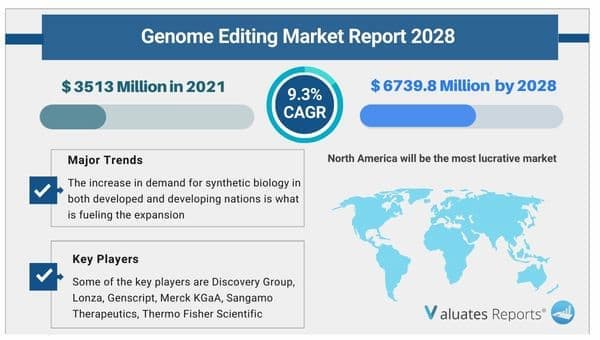
The global Genome Editing market size is projected to reach USD 6739.8 Million by 2028, from USD 3513 Million in 2021, at a CAGR of 9.3% during 2022-2028. Key drivers of the genome editing market include the improvements in gene editing technologies for detecting cancer cells.

The growing application of genomics in personalized medicine will fuel the growth of the market during the forecast period. The scope for animal and plant genetic engineering will propel the market growth in the coming years.
Cancer treatment
Several oncological studies and research has gone into developing the right gene editing tool for the specialized treatment of cancers. CRISPR-CAS9 has been developed for engineering oncolytic viruses and immune cells for therapeutic applications. It precisely edits the gene in model organisms and human beings with extreme ease. The techniques are highly customizable and are being adopted in several medical labs around the world which will augment the growth of the genome editing market in the forthcoming years. Over 3 billion letters of human genome DNA are cut more precisely than other editing technologies. The method is a lot faster and the editing can be completed within the course of a few months. CRISPR can be scaled up by using hundreds of guide RNAs for evaluating multiple genes at a time. It is cheaper and picks out genes for accurate drug targets. The DNA insertion or deletion is done through transcriptional activation or repression through multiplex targeting and manipulating only 20 nucleotide components of an RNA. This enhances specific DNA sequence targeting.
Personalized medicine
The field of precision medicine is evolving at a rapid pace with the development of novel therapeutic methods such as genome editing. It ensures tailored modification to correct genetic mutations in cells and tissues for the treatment and diagnosis of a large number of diseases. It gives the opportunity to utilize disease-specific and patient-specific mutations as a platform for drug discovery, screening, and therapy. This will expand the growth of the genome editing market in the upcoming years. The treatment is tailored as per the genetic background of each individual patient. The simplicity, speed, and cost-effectiveness lead to efficient results within less time. The protein binding sites are disrupted and the resultant DNA is cleaved only when a perfect match is available which prevents mismatches and offset targets.
Widespread applications
Genomics has large-scale applications in agriculture and veterinary sciences. Earlier it was restricted to forensic studies but has spread to other fields as well. It is being deployed in marine engineering for developing nutraceuticals from algae. DNA barcoding is used for detecting fish larvae, and eggs and for the accurate assessment of the fish population. This will spur the growth of the genome editing market in the subsequent years. It is utilized in plants for creating genetically modified crops for improved yield. The technology is helpful in reducing allergens, and saturated and trans fats. It is also helpful in improving nutrients in crops. It draws put traits from both animals and plants that are wholesome and sustainable. Diseases like PRRS in pigs are eliminated and the process is much faster than traditional breeding methodologies. This boosts natural immunity and livestock performance.
High cost and ethical concerns
Genomic instruments come with advanced features and added functionalities which means the price range is usually premium and placed at a higher rate. The technology is novel. Many pharmaceutical companies and research laboratories acquire genome editing tools at huge expenses. This shoots up the capital expenditure. It is out of reach of small and mid-sized firms due to several budgetary constraints. This will deter the growth of the genome editing market in the forthcoming years. Additionally, the rapid progress and huge popularity of the technique are raising certain ethical concerns. The attempts to edit human zygotes are dangerous and there is an urgent need for strict regulation. Before changing Human genetic information a universal consensus standard is required with strict guidance and compliance.
Based on type, the CRISPR segment is expected to dominate in the genome editing market share due to ease of use and simplistic design in comparison to other gene editing techniques.
Based on application, the cell line engineering segment will grow the highest due to the increasing focus on stem cell-based therapy treatment.
Based on region, North America will grow the highest in the genome editing market share due to rising investments, increasing R&D initiatives in gene therapy, and the use of GMO crops along with the presence of key manufacturers.
|
Report Metric |
Details |
|
Report Name |
Genome Editing Market |
|
Market size value in 2021 |
USD 3513 Million |
|
Revenue forecast in 2028 |
USD 6739.8 Million |
|
Growth Rate |
CAGR of 9.3% |
|
Base year considered |
2021 |
|
Forecast Period |
2022-2028 |
|
By Type |
CRISPR, TALEN, ZFN |
|
By Application |
Animal Genetic Engineering, Cell Line Engineering, Plant Genetic Engineering |
|
Report Coverage |
Revenue & volume forecast, company share, competitive landscape, growth factors, and trends |
|
Segments Covered |
By Type, Application, and Region |
|
Geographic Regions Covered |
North America, Europe, Asia Pacific, Latin America, Middle East & Africa |
Ans. The global Genome Editing market size is projected to reach USD 6739.8 Million by 2028, from USD 3513 Million in 2021, at a CAGR of 9.3% during 2022-2028.
Ans. Some of the Major companies are Horizon Discovery Group, Lonza, Genscript, Merck KGaA, Sangamo Therapeutics, Thermo Fisher Scientific
Ans. Yes, the report includes a COVID-19 impact analysis. Also, it is further extended into every individual segment of the report.
$2900
$4350
$5800
HAVE A QUERY?
OUR CUSTOMER

Add to Cart
Add to Cart
Add to Cart
Add to Cart